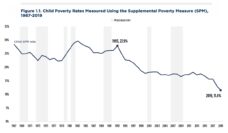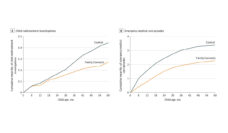The COVID-19 pandemic has drawn attention to vast income inequality in the U.S. and globally. The U.S. Census Bureau reports that income inequality has increased for the first time since 2011. While this statistic provides an overall picture of income inequality in the country, smaller areas, such as counties where the rich and poor live side by side, can experience economic disparities more acutely.
Why should we care about income inequality in counties? One reason is that research has documented that people living in more unequal societies tend to have worse health outcomes than those living in more equal societies. So far, most studies examining the impacts of income inequality have focused on adult and child health outcomes, such as life expectancy and infant mortality. Child maltreatment, a significant public health problem affecting millions of children in the U.S., however, is less studied. Only one study has looked at the impact of county-level income inequality on child maltreatment using data in 2005-2009. Economic circumstances across the U.S. have changed considerably, and thus these results may not reflect economic climates and county-level conditions over the past decade.
Using data from the National Child Abuse and Neglect Data System and the American Community Survey from 2009 through 2018, my colleagues and I investigated the link between child maltreatment at the county level, income inequality (measured by the Gini index), and poverty rates (measured by the percentage of children living in households with income at or below the federal poverty line).
We found that counties with higher levels of income inequality had higher rates of child maltreatment, as determined by state child welfare agencies. This was true no matter what the counties’ poverty rates were. Notably, counties with high poverty rates were even more affected by income inequality. In other words, counties with high levels of income inequality and high overall poverty rates had the largest maltreatment rates among the examined counties.
To put it simply, when poor and marginalized communities have limited access to resources and support, child maltreatment reports can increase.
The reasons for the link between income inequality and child maltreatment are complex, but several potential explanations exist. First, rising income inequality can directly affect individual family income. As the rich became richer and the poor became poorer, families on the lower rungs of the socioeconomic ladder struggle with accessing resources, such as childcare or community support. These increased disadvantages make it harder for low-income families to take care of their children, eventually leading to increased child maltreatment risks.
Second, income inequality can influence child maltreatment indirectly. When people live in an unequal county, they might not trust or feel like they belong to their community. This can lead to emotional stress, even for those whose income remained unchanged, eventually increasing parental stress and disrupting parents’ caregiving abilities.
A third possible reason is that unequal counties may have more child welfare surveillance and reporting. Unequal counties are often characterized by a disproportionate racial composition and residential segregation. This can cause low-income families to be subjected to surveillance and criminalization by mandated reporters, such as teachers, social workers, doctors, and police, further exacerbating the mistrust in these communities. Consequently, bias rather than actual parental maltreatment behaviors lead to increased child maltreatment report rates (as determined by the child welfare agencies) in unequal counties.
To put it simply, when poor and marginalized communities have limited access to resources and support, child maltreatment reports can increase. Counties are essential because they determine how child welfare services are provided. Policymakers and practitioners must prioritize programs and strategies that promote an equal distribution of resources within a county to reduce the risk of child maltreatment. Examples may include reducing residential segregation, investing in public education, and expanding safety net supports.
Further, oftentimes, reporting on child maltreatment, particularly neglect, reveals a family’s inability to meet the child’s basic needs. The mandatory reporting policy is designed to protect children but can also end up misrepresenting poverty as neglect. Policymakers can also refine mandatory reporting policies to better respond to the complex needs and challenges facing families involved in poverty and child maltreatment. As the U.S. becomes more unequal, it’s crucial to develop plans to address this issue and build stronger communities that can protect children.
Photo via Getty Images














